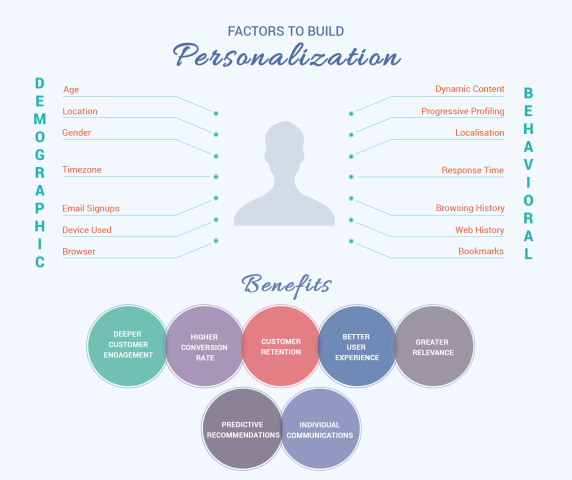B2B’s have always opted for a very formal digital presence, focusing only on developing their product line not their brand image. But now they have to face the competition from mushrooming startups who focus mainly on building an amazing web presence, to grab attention and gain traction. Building flashy website is not gonna cut it, there are many other aesthetics involved that take a user from awareness stage to sales closure.
Companies have different goals to achieve from their sites; some want to grab attention, some want lead generation, some want to attract talent, and rest are keeping it for informational purposes. So, what are these aesthetics that large corporations need to build an effective user centric website in 2017?
Chart out a user journey to start with
Corporations have a wealth of data, but a story roped around information that communicates their frustrations and experiences and helps them understand what company stands for, is more useful.
Customer journey map is about identifying key interactions a customer has with the organization. It starts right from the first contact through the process of engagement and how it turns into a long term relationship. This includes details such as user’s feelings, motivations, questions and confusions at every touch points. User journey is the MOST important component for any site before you start building it. It helps every crafting member to…
- Understand the context of user
- Identify the gaps between devices, departments, and channels
- Enhance customer experience
- Help organizations in differentiating with digital experience of competitors
Website needs to have a dialogue with the user
Just because a website is the face of the company, we give more preference to visuals instead of right interactions. The website has to sync well with the nature of the business you are dealing with, and a sophisticated messaging helps in hitting the right kind of users and inquiries. Moreover, every design element such as images, videos, font, icons should be in harmony with the goal of the website. If all these things are not complimenting each other, then doesn’t matter how well you have planned each component, users will be disappointed and this will result in increased bounce rates.
Personalize experience for your user

Corporate websites can’t play with personalization in the same way as consumer sites. Dynamic content is the most relevant way to nurture the path of personalization. Intuit is one of the most appreciated corporate sites and put a lot of effort in personalizing content for their customers. So, when a visitor lands on the blog page, they have been offered an eBook, and when they have already read the book, new eBooks or other relevant CTA buttons help to move them up the funnel.
Intelligent sites that optimize content, create a virtuous circle where the visitor is always offered something new using predictive analysis.
Mobile first approach is the key
The 1.2 billion mobile web users worldwide are giving a tremendous boost to Responsive design in all formats. When you try to trim down the desktop version for mobile, it ends up looking unpolished. Whereas with progressive enhancement, you start with a lean mobile design. So, instead of cutting down, you can accommodate better features when scaling for the desktop.
But responsive is not the only way out. Progressive Web Apps have been trying to bring in the look and feel of mobile apps with key features such as notifications and offline mode. The mobile app experience also got a stiff competition from Accelerated Mobile Pages in recent times, with more websites adopting a lean shell that’s faster and user friendly.
Be human centered than being user centered
The main objective of a user centered design is to build a functional website. Whereas, the human centered design is when a designer takes care of all human needs to serve its users. Crafting the right problem statement to solve using design thinking is the key to success. Actual insights are employed to create a human centered design where your website answers the questions with the right information. You can incorporate rapid prototyping, user testing, and feedback throughout the entire process, resulting in a website that’s user friendly.
It’s not B2B anymore, consumerization is taking over
B2B websites have long followed the text heavy templates as their audience are highly targeted business buyers. However, this approach has become outdated. New age buyers have no time to go through the boring text only websites. B2B experience is becoming more B2C like, with videos and interactive graphics replacing the plain case studies. Interactive long scrolls where users discover well crafted content through a series of graphics, videos and text, paint a picture of a firm that vibrant and happening.
Focus not only on driving sales but also on attracting talent

Websites are crucial for setting the first impression among the candidates besides Glassdoor. However, for long corporate websites have packed career section to an isolated island in the website. But here’s what a candidate expects from a career section.
- Millennials look for ways to access content instantly and therefore are less inclined to jump to different pages. Hence, you should tightly integrate careers section with the home page.
- Career section should be more than a job listing page, it should feature good stuff to impress job seekers.
- Introducing a company is most important where attractiveness and information should blend to establish a global brand.
- Branding is important to attract millennials, take a cue from Apple, whose career video carries a wow factor. You can even add video testimonials from staff raving about the company.
- You can link career forms with social media sites such as Google+, Yahoo, and LinkedIn.
Social media matters the most
Social media is not limited to B2C brands anymore, B2B giants are also making a big splash in the social media pool. They are using not just LinkedIn and Twitter, but also Facebook, Instagram, Google+, Pinterest, and even Snapchat. YouTube and Slideshare also stand out for promoting the corporate content videos and case studies.
- LinkedIn has a vast base of professionals, making it the best platform for promoting B2B content. Microsoft with 3 million followers, shares behind the scenes product insights, tips for marketers, and tales from Media hub on their company page.
- Twitter has a brand loyalty attached to its users where followers and great content result in loyal brand promotion. IT behemoth Oracle does it really well, showing a softer philanthropic side to its nearly 400,000 followers.
- An average person spends 18 minutes per visit on Facebook and with Facebook Pages and Instant articles. It’s evolving as a great place to explore and promote content. Salesforce is killing it on Facebook, where the focus in not the selling its products, but saluting its employees and showcasing its customers.
- Pharmaceutical giant, Novartis is working its way by piquing the curiosity of its 14.7k followers on Instagram. It’s trailing the history of medicine and Novartis through attractive and interactive snapshots.
- You can’t afford to dismiss the Google+ platform. It has a powerful algorithmic factor that connects the content with a larger audience. GE posts a steady stream of updates, sharing traditional and animated graphics as well as traditional posts and announcements with the relevant use of hashtags.
- HubSpot is using Snapchat to give the audience a sneak peak of their unique culture, employees, perks, and inbound philosophy. You can even apply to HubSpot using Snapchat.
A few points to remember
Design thinking has been given a direct entry to corporate boardroom these days, but websites are still lagging on innovation. It needs imaginative designers, courageous top management, goal oriented content strategists and a lot of iterations to create compelling stories that resonate with customers and job seekers. Now you have to choose whether you want to follow yet another bland corporate mayhem or embrace the design thinking approach to finding what’s right for your audience. Why don’t you talk to our design thinking experts and take a swing?
